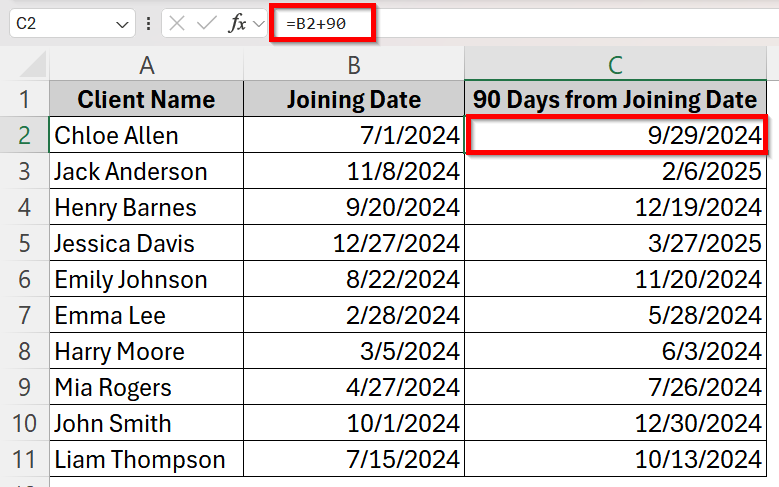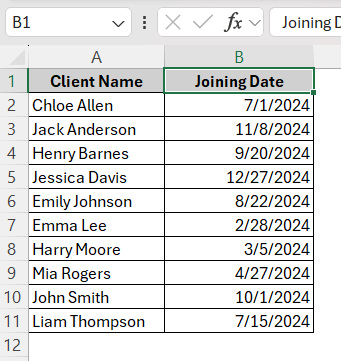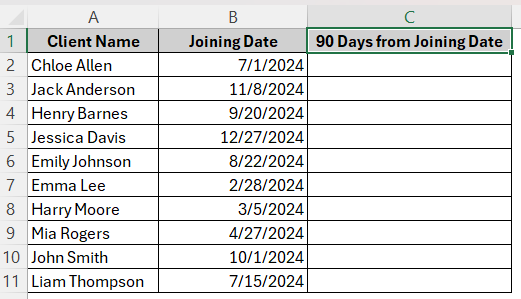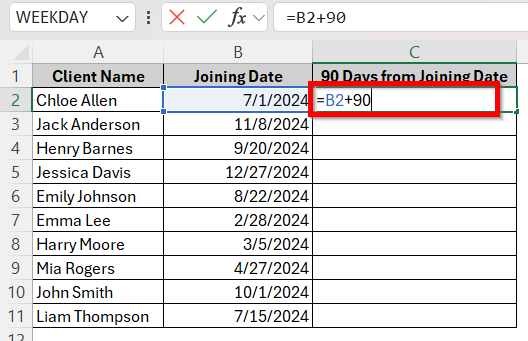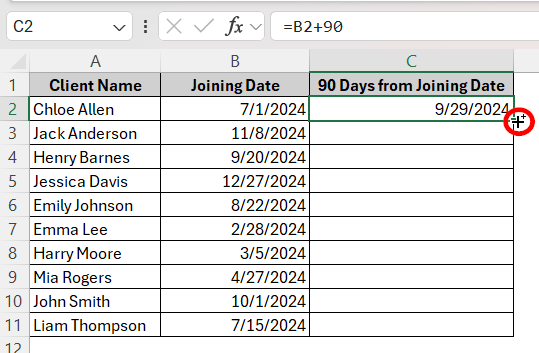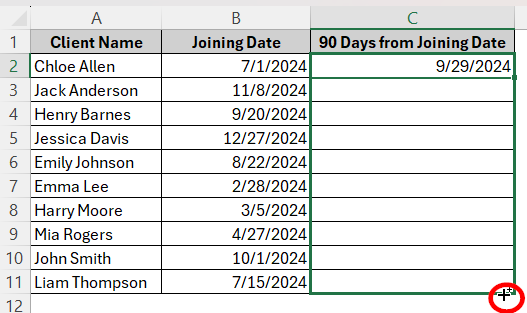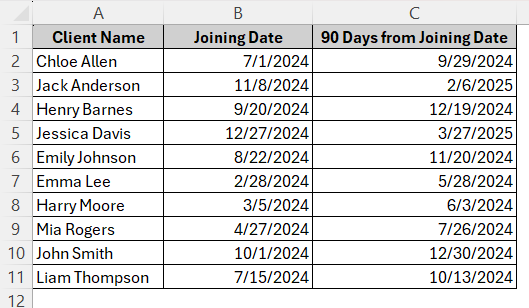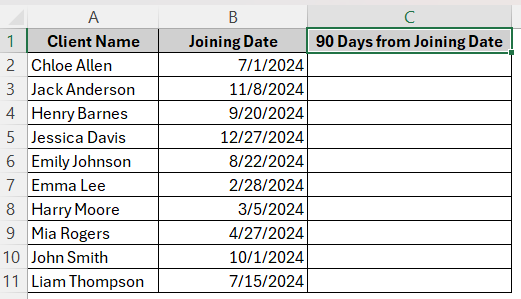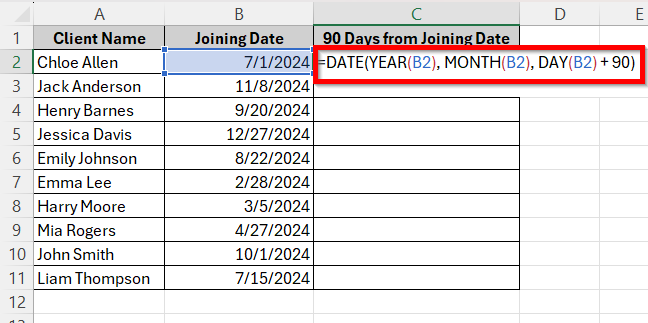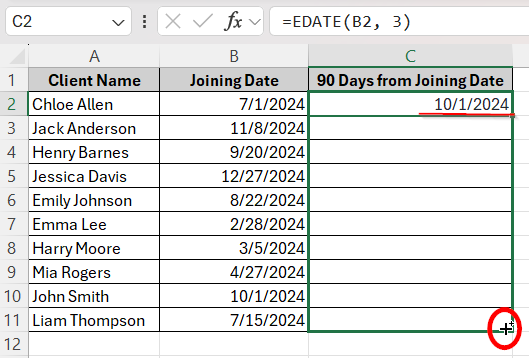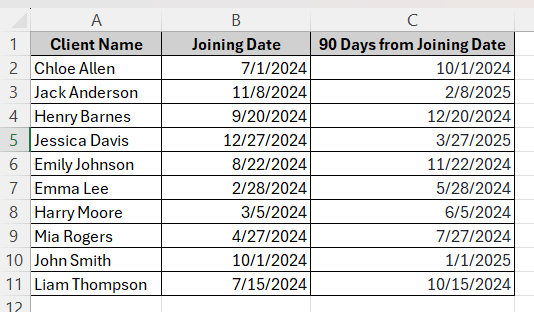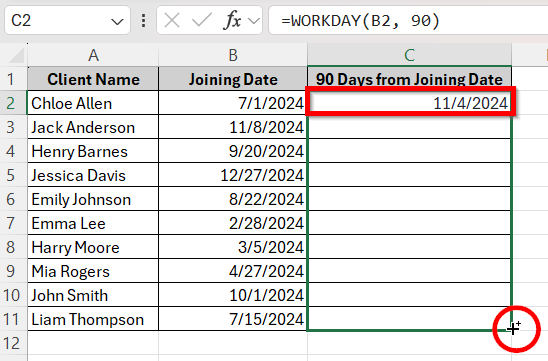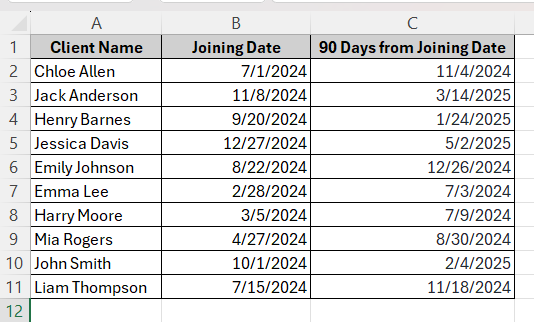For managing schedules, project timeline and deadlines, calculating dates in Excel is a very important task to know. One frequently used operation you might need to perform in Excel is determining a date that falls 90 days from a specific starting point. Whether you’re setting payment terms, tracking probation periods, or projecting milestones, it’s often essential to know how to calculate 90 days from date in Excel.
➤ Create a separate column to contain the dates that are 90 days ahead of the starting date.
➤ In the first cell of this column, type the formula =StartDate cell+90.
➤ Here, the start date is in cell B2, so the formula will be =B2+90.
➤ Click and drag the plus sign beside the first cell now to apply the formula to all the cells in the column.
In this article, we’ll walk you through four simple methods to calculate 90 days from a given date in Excel. You will know how to factor in both normal calendar days and weekdays during this calculation.
Basic Date Addition Using a Simple Formula
The simplest and quickest method to add 90 days from a date is using basic arithmetic. All you need to do is take the start date cell number and write a formula by adding 90 with it. This method is used without worrying about weekends and holidays. Here is our sample dataset where the date follows the standard DATE format month/day/year:
We need to count 90 days from the dates in column B under the heading Joining date for these clients. Follow these steps to complete the task:
➤ We will introduce a new Column C where the heading will be 90 Days from Joining Date in cell C1.
➤ Now, click on cell C2 and type in the formula B2+90. Here, the starting date is in cell B2, that’s why we use this. The general formula will be your StartDate cell+90 in case of different datasets.
➤ The corresponding date from the starting date 7/1/2024 will be 9/29/2024 in cell C2 now. Hover the cursor over the bottom right corner of the cell C2 where you will see the plus sign.
➤ Click and drag the plus sign to the end to apply the formula in the entire column C.
➤ Now, we have all the dates exactly 90 days away from the starting dates, including weekends.
Calculate 90 Days from a Date using the DATE Function
This is another simple method for calculating 90 days from a date. The date in cell B2 is broken down into its year, month, and day components in this method, which then adds 90 to the day. If adding 90 days causes the date to fall into a new month or year, the DATE function will automatically manage month and year rollovers. Here is how you can use this method:
➤ We will introduce a new Column C where the heading will be 90 Days from Joining Date in cell C1.
➤ Click on cell C2 and type in the formula:
=DATE(YEAR(B2), MONTH(B2), DAY(B2) + 90)
➤ Click and drag the plus sign at the bottom right corner to the end to apply the formula in the entire column C.
➤ Now, we have all the dates exactly 90 days away from the starting dates, including weekends.
Use the EDATE Function to Add 3 Months from The Date
Since 90 days are roughly 3 months, give or take 1-2 days, sometimes you might need to calculate the date based on months. In those cases, the EDATE function comes in handy where the function will get you the exact same day, just three months later. However, this does not ensure exactly 90 days ahead due to the 31st of various months. Here is how you can use this:
➤ We will introduce a new Column C where the heading will be 90 Days from Joining Date in cell C1.
➤ Click on cell C2 and type in the formula =EDATE(B2, 3) to get the date exactly three months from the joining date.
➤ Click and drag the plus sign at the bottom right corner to the end to apply the formula in the entire column C.
➤ Now, we have the same dates exactly 3 months later. Remember to only use this method during month based calculations, not exact 90 days calculations.
Calculate 90 Business Days with WORKDAY Function (Exclude Weekends)
In case of managing project deadlines and company schedules, the weekends need to be taken into account. In these cases, you will need to count 90 business days which are only weekdays (Monday to Friday) to correctly get the specific dates. Follow the steps below to utilize the WORKDAY function:
➤ We will introduce a new Column C where the heading will be 90 Days from Joining Date in cell C1.
➤ Click on cell C2 and type the formula =WORKDAY(A1, 90). This will add 90 working days to the existing date, excluding the weekends (Saturday and Sunday).
➤ Click and drag the plus sign at the bottom right corner to the end to apply the formula in the entire column C.
➤ Now, we have found the 90 working days ahead from the starting date.
Frequently Asked Questions
Does Excel count the start date when adding 90 days?
No, Excel doesn’t count the start date when calculating 90 days from it. The first day in the count is the next day from the start date. If you want to count the start date, you will need to add +89 in the formulas instead of +90.
How to Calculate 90 Days before the Start Date in Excel?
Similar to calculating 90 days after a start date, you can use any formulas mentioned above. However, instead of addition, you will need to subtract the 90 days in the formula. So the formula will be: =StartDate -90 or =WORKDAY(StartDate, -90).
How Can I Calculate 90 Days from Today’s Date in Excel?
You can use the TODAY function to make the calculation dynamic. In order to count 90 calendar days from today’s date, use =TODAY() + 90. To count 90 business days from today’s date, use =WORKDAY(TODAY(), 90).
Wrapping Up
When working across months of varying lengths or taking weekends and holidays into account, attempting to manually count 90 days from a particular date might result in mistakes and inefficiencies. Depending on your demands, Excel provides a variety of techniques, ranging from rapid math to business-day-specific formulas that factor in weekends.
Gaining proficiency in these methods will enable you to confidently and easily manage a variety of real-world planning problems, whether you’re managing a financial cycle, HR timetable, or project milestone.

